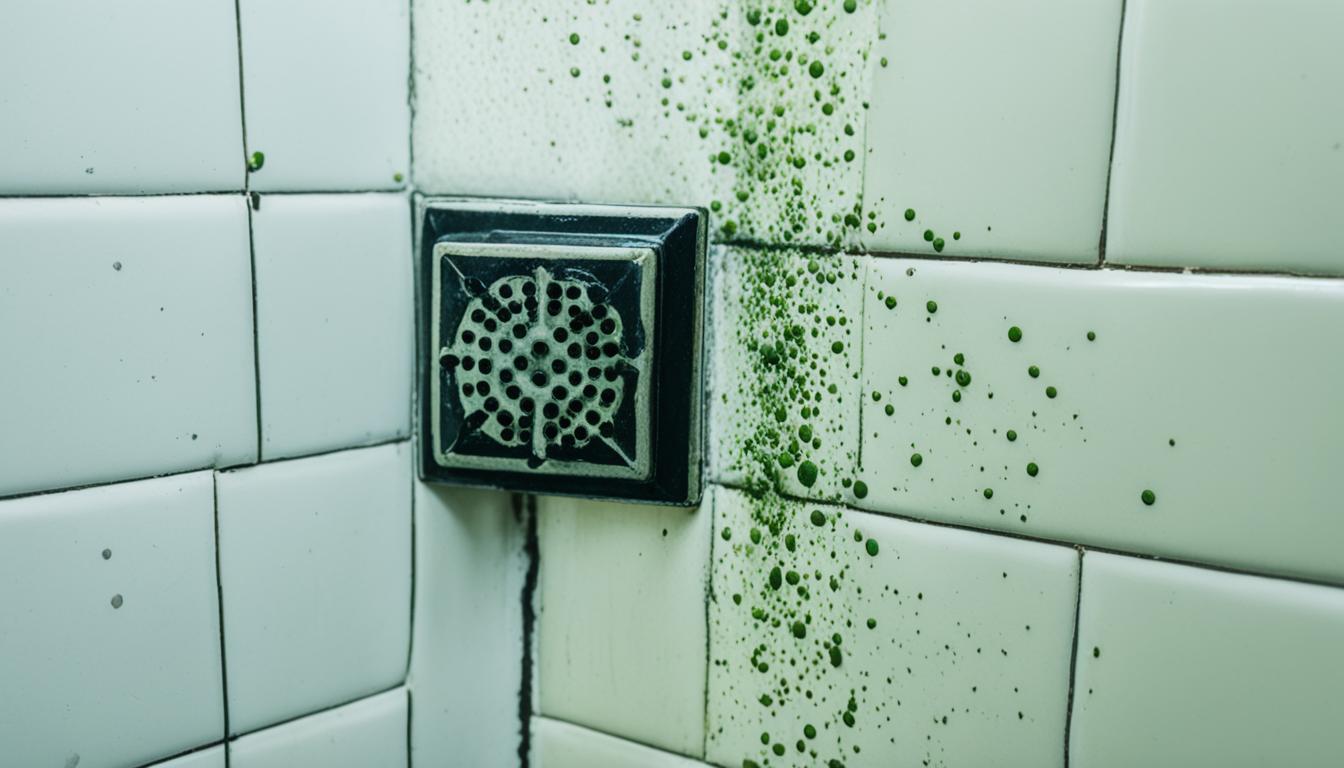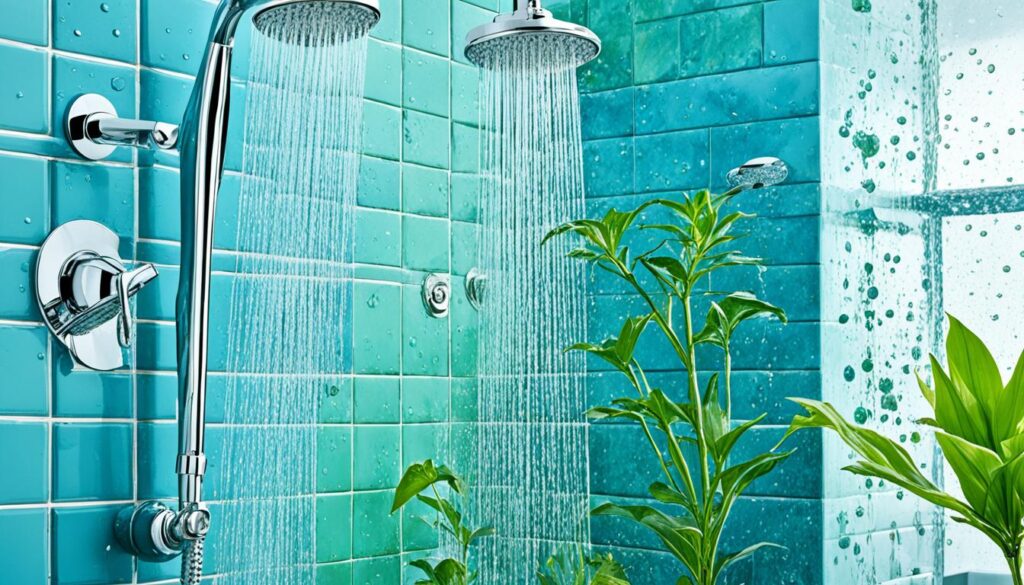
Mold in Shower: Prevention and Safe Removal Tips
Discover the secrets to keeping your shower mold-free and maintaining a clean, healthy bathroom environment. In this section, we will discuss the importance of mold prevention and provide expert tips on how to safely remove it if necessary.
Mold can be a common issue in showers due to the damp and humid conditions. Not only is it unsightly, but it can also pose significant health risks if left untreated. By taking proactive measures, you can prevent mold growth and ensure a hygienic bathing experience for you and your family.
Key Takeaways:
- Preventing mold in the shower is crucial for a clean and healthy bathroom environment.
- Regular maintenance, moisture control, and a proper cleaning routine are essential for mold prevention.
- Safe techniques and appropriate cleaning products are necessary for effective mold removal.
- Wearing protective gear is important when dealing with mold to avoid health risks.
- Consider seeking professional assistance for mold assessments and remediation services.
How to Prevent Mold in Your Shower
Mold growth in your shower can be both unsightly and harmful to your health. To keep your bathroom clean and mold-free, it’s essential to implement preventive measures that target moisture control and establish a regular cleaning routine. Follow these effective strategies to prevent mold from taking hold in your shower:
- Keep your shower well-ventilated: Proper ventilation is key to preventing humidity buildup, which can contribute to mold growth. Make sure your bathroom has a functioning exhaust fan or open a window to allow fresh air to circulate.
- Fix any leaks promptly: Leaky faucets, pipes, or showerheads can create a moist environment that promotes mold growth. Inspect your shower regularly and address any leaks or plumbing issues immediately.
- Wipe down your shower after each use: Use a squeegee or towel to remove excess water from the shower walls and floor after each use. This helps to prevent the accumulation of moisture and discourages mold growth.
- Clean your shower regularly: Develop a consistent cleaning routine for your shower, using appropriate cleaning products and techniques. Regularly scrub the surfaces, including grout lines, to remove any mold spores or buildup that may be present.
- Use mold-resistant materials: When renovating or building a new shower, opt for mold-resistant materials such as mold-resistant drywall or paint. These materials can help inhibit mold growth and make cleaning easier.

“Proper ventilation, prompt leak fixes, regular cleaning, and the use of mold-resistant materials are effective strategies to prevent mold growth in your shower.”
Implementing these preventive measures will help you maintain a clean and mold-free shower. However, if you do encounter mold in your shower despite your best efforts, it’s crucial to address the issue promptly and safely. In the next section, we will discuss safe techniques for mold removal.
Safe Techniques for Mold Removal
Mold removal in your shower requires careful attention and the use of safe techniques to prevent health hazards and further damage. By following these guidelines, you can effectively eliminate mold while prioritizing your well-being.
Choosing the Right Cleaning Products
When it comes to mold removal, using the right cleaning products is crucial. Opt for environmentally-friendly solutions that are specifically formulated for mold remediation. Look for products that contain ingredients like hydrogen peroxide or vinegar, as they are effective in killing mold without posing significant health risks.
It’s important to read and follow the instructions provided by the manufacturer when using these cleaning products. This ensures you use the correct dilution ratios and apply the product safely.
Wearing Protective Gear
Prior to starting the mold removal process, it’s essential to protect yourself from potential health hazards. Wear appropriate protective gear, including gloves, goggles, and an N95 respirator mask to prevent direct contact with mold spores and minimize exposure to airborne particles.
The gloves should be chemical-resistant to shield your skin from any potential irritation or allergic reactions caused by the cleaning products. Goggles protect your eyes from splashes or airborne particles that may irritate or cause damage. The N95 respirator mask filters out mold spores and other harmful contaminants, ensuring you breathe clean air during the removal process.
Ensuring Proper Ventilation
Proper ventilation is crucial during mold removal to minimize the concentration of airborne mold spores. Open windows and doors to allow fresh air to circulate throughout the area. Consider using fans or dehumidifiers to help dry out the environment, reducing moisture levels and inhibiting future mold growth.
Safe Disposal of Contaminated Materials
After removing mold-infested materials, such as shower curtains or silicone seals, it’s essential to safely dispose of them. Place the materials in plastic bags and seal them tightly to prevent the spread of mold spores. Dispose of the bags in accordance with local regulations for hazardous waste disposal or consult with your local waste management authority for proper guidance.
Remember, safety should be your top priority when dealing with mold removal in your shower. By using appropriate cleaning products, wearing protective gear, ensuring proper ventilation, and practicing safe disposal methods, you can effectively eliminate mold while safeguarding your health and well-being.
| Safe Techniques for Mold Removal | Key Points |
|---|---|
| Choose the Right Cleaning Products | Use environmentally-friendly mold remediation solutions that contain hydrogen peroxide or vinegar. |
| Wear Protective Gear | Protect yourself with gloves, goggles, and an N95 respirator mask to minimize exposure to mold spores. |
| Ensure Proper Ventilation | Open windows, use fans, or dehumidifiers to improve air circulation and reduce moisture levels. |
| Safe Disposal of Contaminated Materials | Seal mold-infested materials in plastic bags and follow local regulations for disposal. |

Conclusion
In conclusion, maintaining a clean and healthy bathroom environment by preventing mold in your shower is essential. Following the expert tips and techniques discussed in this article will help you proactively prevent mold growth and ensure the safety of your household. By implementing regular shower maintenance, controlling moisture levels, and establishing a proper cleaning routine, you can significantly reduce the chances of mold formation.
If you do encounter mold in your shower, it is crucial to remove it safely and effectively. Remember to select appropriate cleaning products and wear protective gear, such as gloves and a mask, to avoid inhaling harmful spores. However, in severe cases or if you are uncertain about handling the mold yourself, it is highly recommended to seek professional assistance for mold assessments and remediation services.
One such reputable service provider is Fix Mold Miami. Their team of experts specializes in mold identification, assessment, and safe removal. With their in-depth knowledge and experience, you can trust them to address your mold concerns efficiently and effectively, ensuring a mold-free and healthy bathroom environment. Don’t hesitate to contact Fix Mold Miami for professional assistance and peace of mind.




